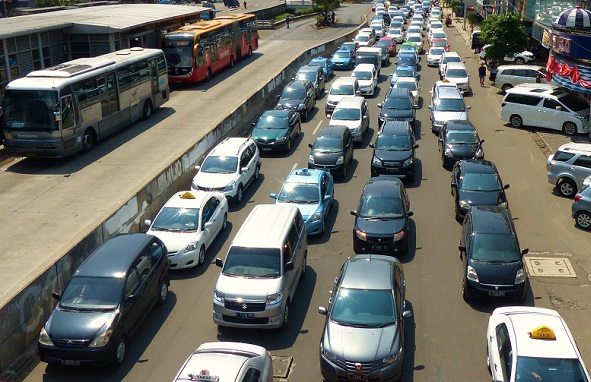Indonesia's 2014 Annual Car Sales Fall on Bleak Economy & Fuel Hike
Domestic car sales in Indonesia declined 15 percent to 91,449 vehicles in November 2014 (from the same month last year). Declining car sales in Southeast Asia’s largest economy are believed to be caused by the recent subsidized fuel price hike. In mid-November the Joko Widodo-led government raised prices of subsidized fuels (low-octane gasoline and diesel) over 30 percent in order to reduce state spending on fuel consumption and reallocate funds to structural economic and social development.

However, higher fuel prices bring severe inflationary pressures as transportation of goods and people becomes more expensive (multiplier effect) and caused the central bank to introduce a higher interest rate environment (the key interest rate being 7.75 percent currently), thus reducing both people’s purchasing power and consumer confidence. In this context, consumers tend to postpone a car or motorcycle purchase.
Rahmat Samulo, Marketing Director of Toyota Astra Motor, said that the slowdown in Indonesian car sales will continue into the first half of 2015. Provided that the government manages to reallocate the funds (which are saved by the fuel price hike) to structural sectors, such as infrastructure development, then car sales will bounce back in the second half of 2015. Samulo expects to see relatively stagnant growth in the domestic car industry over the next two years. After this ‘consolidation phase’, the industry is able to grow rapidly again as the country is still characterized by a low per capita car ownership ratio (less than four percent of the Indonesian population owns a vehicle). Moreover, by 2016, the Indonesian economy should expand at an impressive pace again. Between 2011 and 2014, the economy has shown a slowing growth trend (from GDP growth of 6.5 percent y/y in 2011 to 5.2 percent y/y in 2014). Forecasts suggest that GDP growth will rebound to 5.8 percent (y/y) in 2015, and then to +7 percent (y/y) in 2016 (provided that external factors - i.e. the global economy - are conducive). Accelerated growth will enhance people’s purchasing power and is expected to give rise to higher car sales figures.
Accumulatively, - based on the preliminary November figure - Indonesian car sales (wholesales) reached 1,129,746 vehicles in the January-November 2014 period, or 0.2 percent down from the same period last year (1,132,210 units). The weak November car sales result implies that it is highly unlikely for Indonesia to meet the car sales target of the Indonesian Automotive Industry Association (Gaikindo) at 1,250,000 cars by the year-end. In fact, it may be the first time since 2009 that Indonesia experiences negative annual car sales growth in 2014.
Indonesian Car Sales (CBU):
| Month | Sold Cars 2012 | Sold Cars 2013 | Sold Cars 2014 |
| January | 76,427 | 96,718 | 103,563 |
| February | 86,486 | 103,278 | 111,861 |
| March | 87,917 | 95,996 | 113,095 |
| April | 87,144 | 102,257 | 106,052 |
| May | 95,541 | 99,697 | 96,927 |
| June | 101,746 | 104,268 | 110,572 |
| July | 102,511 | 112,178 | 91,409 |
| August | 76,445 | 77,964 | 96,753 |
| September | 102,100 | 115,974 | 102,709 |
| October | 106,754 | 112,039 | 105,357 |
| November | 103,703 | 111,841 | 91,449 |
| December | 89,456 | 97,706 | |
| Total | 1,116,230 |
1,229,916 |
1,129,746 |
| 2008 | 2009 | 2010 | 2011 | 2012 | 2013 | 2014¹ | |
| Indonesian Car Sales (number of car units) |
607,805 | 486,061 | 764,710 | 894,164 | 1,116,230 |
1,229,916 | 1,250,000 |
| Indonesian Exports (number of car units) |
100,982 | 56,669 | 85,769 | 107,932 | 173,368 | 170,907 | 200,000 |
¹ Gaikindo forecast
Source: Gaikindo
Apart from the economic slowdown, weakening purchasing power, poor infrastructure and higher subsidized fuel prices, players in Indonesia’s car industry also have to deal with increased competition due to the influx of several car manufacturers in recent years. For example, Astra International (Southeast Asia's largest automotive group) saw its market share decline from 58 percent in 2009 to 51 percent in the January-October 2014 period.
Further Reading:
• Low Cost Green Cars Support Car Sales in Indonesia
• Growth of Indonesian Car Sales Falls amid Slowing Economic Expansion
• Impact of Higher Subsidized Fuel Prices on Indonesia’s Car Industry
Bahas
Silakan login atau berlangganan untuk mengomentari kolom ini

